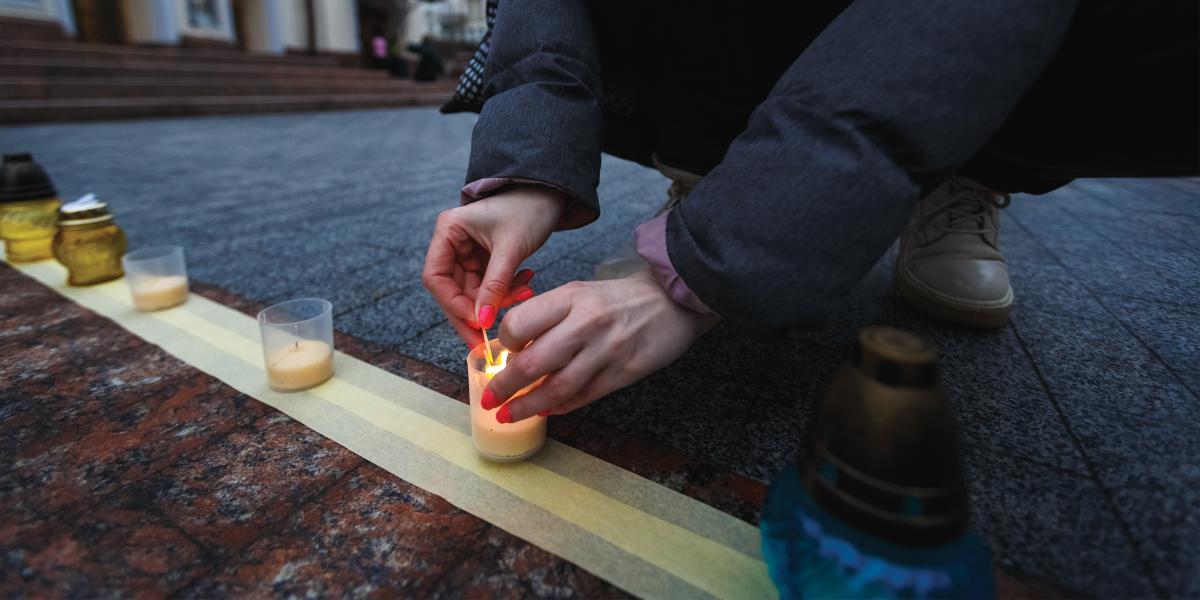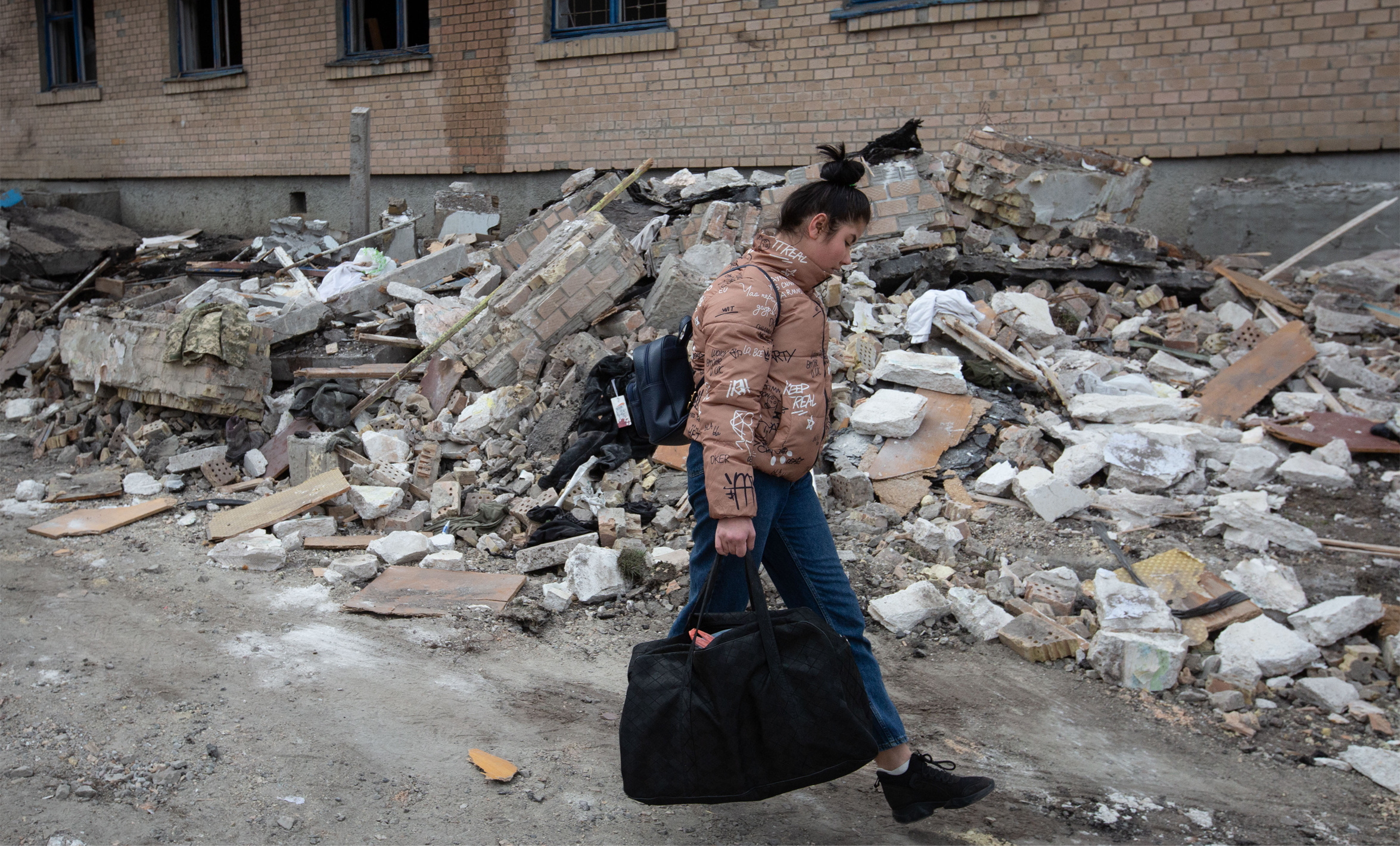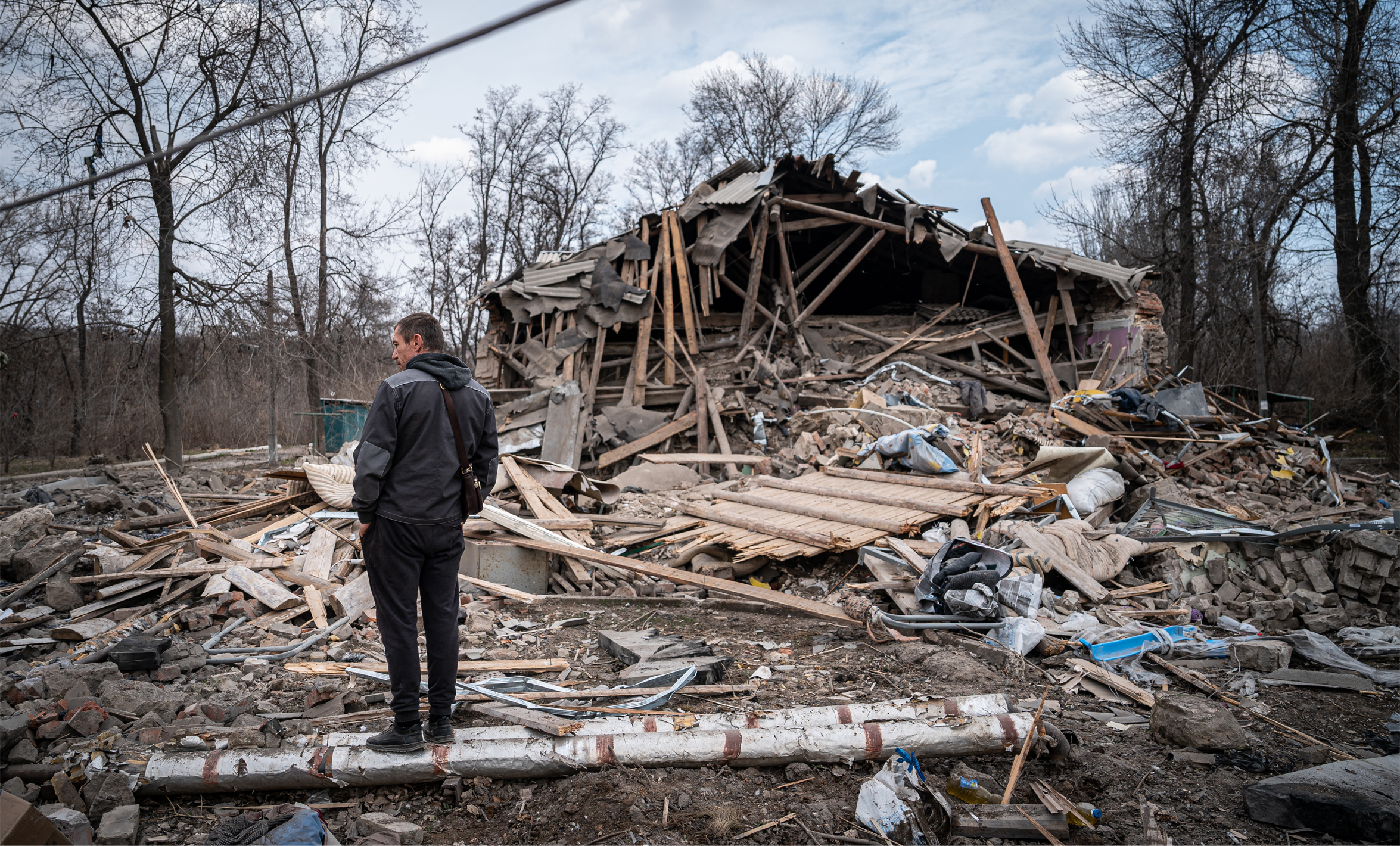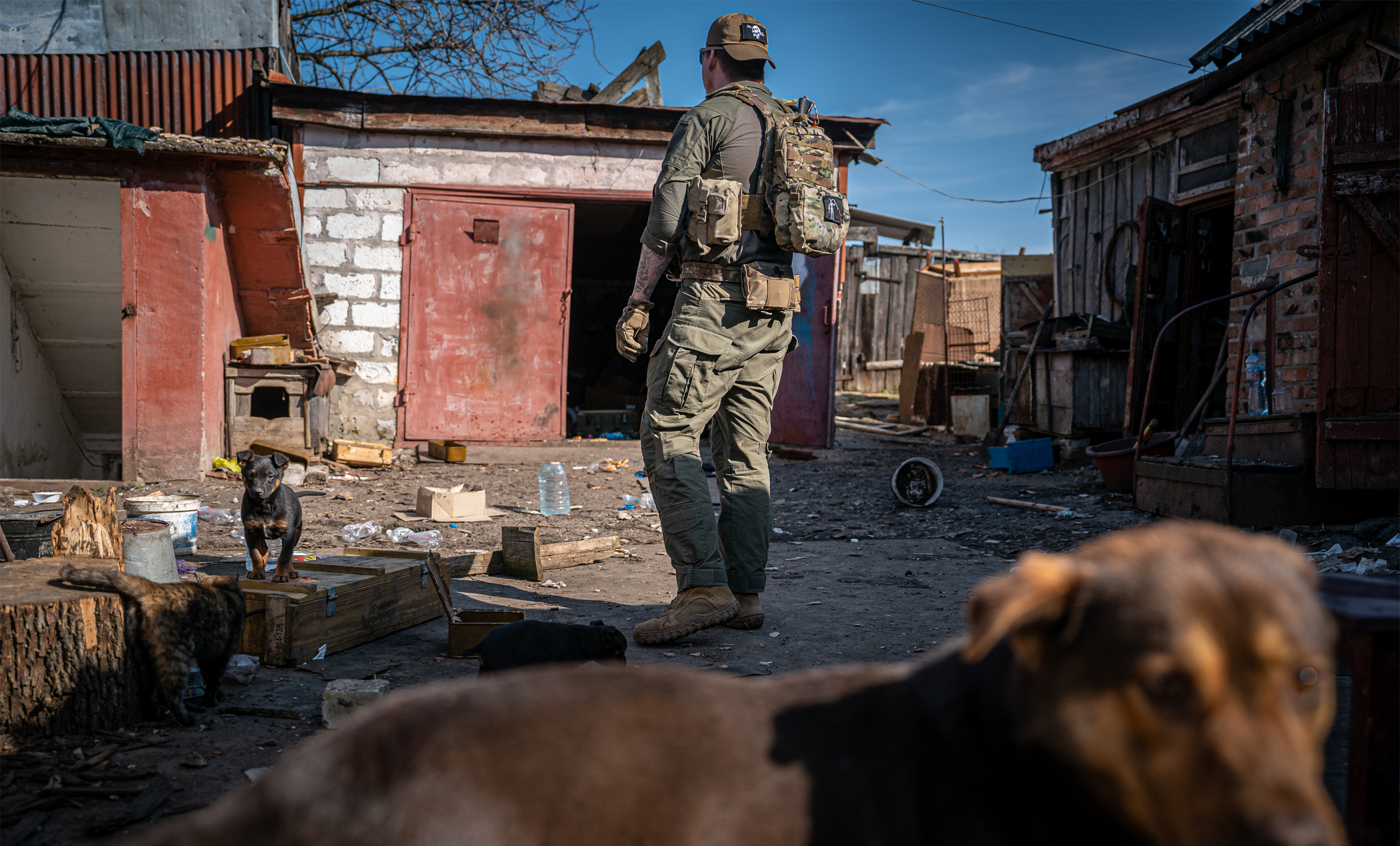Peace of Mind: Protecting Mental Health in Ukraine
A story of promise and healing in mental health rises from war-torn Ukraine.
On a Thursday afternoon in February 2023, almost exactly one year after Russian forces invaded her country, a young Ukrainian woman named Olga makes several failed attempts to connect to a Zoom video call before finally appearing on screen.
She has long brown hair, brown eyes, and a friendly, bright face. She says, through an interpreter, that she’s able to share some of what’s happened to her over the past year. But she can’t divulge her last name, current location, or other identifying details. She has relatives and friends living in Russian-occupied territories in Ukraine, and she doesn’t want to put them at risk. She hesitates even to share her age, saying only that she is in her 20s.
Olga is from Mariupol, a city the UN High Commissioner for Human Rights called “the deadliest place in Ukraine” between Feb. 24, 2022, when Russian forces began bombing the city, and April 30, when they assumed full control. During those three months, Russian forces destroyed 90% of Mariupol’s buildings, including hospitals, schools, theaters, and private homes. The UN has confirmed the deaths of 1,348 civilians in Mariupol but acknowledges that the true death toll is likely thousands higher. Bodies are still being discovered in individual and mass graves, and makeshift morgues.
In late March 2022, a Russian missile hit the house in Mariupol where Olga lived with her father, killing him and burying her under rubble. After she was pulled out by Ukrainian soldiers, Olga took shelter in Illich Steel and Iron Works, one of Mariupol’s two massive steel plants. “I had hope that it would be possible to be evacuated from there,” she says. Instead, on April 13, Russian soldiers stormed the plant, rounded up the roughly 2,000 civilians sheltering there, and took them to a filtration camp on the outskirts of the city.
At the camp, they were fingerprinted and interrogated. “They … make you tell everything about your life, and if you know anyone in the Ukrainian military, or know anything about the military,” says Olga. Those who “pass filtration” are released from the camp and sent to shelters in Russian-controlled towns, often against their will.
Olga did not pass filtration. Russian soldiers reviewed her phone’s contents and found a 2014 photo of her standing near a Ukrainian flag. They told her she was a Ukrainian terrorist and began torturing her. “They hit me in the face and put a plastic bag on my head so I couldn’t breathe,” she says. “They kept saying I needed to tell them the truth. When I told them I wasn’t in the military and didn’t know anything, they didn’t believe me.”
The soldiers demanded Olga record a video falsely claiming that Ukrainian soldiers had raped her in the steel plant. “They said if I didn’t obey, they would hurt me with electricity and break my shoulder,” she says. “I had to agree because I understood that if I didn’t, they would hurt me so badly, I would be dreaming about being dead.”
Ultimately Olga was released from the filtration camp without having to make the video. Civilians were banned from leaving Mariupol, but Olga found a way to escape. After a terrifying six-week journey, she made it safely to her relatives’ house in a Ukrainian-controlled town. But the horror wasn’t over. “I felt everything that happened to me was eating me inside,” she says.
She had survived, but she no longer wanted to live.
Two decades earlier and nearly 5,000 miles away, a newly minted clinical psychologist and behavioral scientist named Laura Murray took a job as clinical director for a large-scale project providing mental health care for children experiencing trauma as a result of the Sept. 11, 2001, World Trade Center attacks. Murray and her team quickly ran up against multiple obstacles.
“It would take us weeks just to assess a child, which was ineffective and expensive for a project treating thousands of children,” says Murray, PhD, MA, a senior scientist in Mental Health. “What was most frightening was that many of the providers I supervised had no training in evidence-based treatments. I would sit there with them, and they’d say, ‘These are the 10 kids I saw today, and I don’t know how to help them.’”
That experience helped drive Murray into public health and global mental health, and in 2004, she and Mental Health professor Judith Bass, PhD ’04, MPH, began working with senior scientist Paul Bolton, MBBS, MPH ’93, to create, deliver, and evaluate mental health interventions all over the world. As she had in New York after 9/11, Murray saw again and again that the traditional model of delivering mental health care failed to meet the needs of people after a disaster, or in low-resource areas.
“We needed to change the entire framework,” she says.
In 2010, Murray and Stephanie Skavenski, MPH, MSW, a senior research associate in Mental Health, partnered with Shannon Dorsey, PhD, MS, a psychology and global health researcher at the University of Washington, to create the Common Elements Treatment Approach (CETA). The new model was specifically designed to deliver quality mental health care in low-resource and conflict-ridden areas.
Rather than treating a single diagnosis—depression, anxiety, trauma, substance use—CETA addresses multiple problems and symptoms with one program.
“People show up with lack of energy, interest, poor appetite, they can’t sleep. If you put them all together, you’d say they were depressed,” says Bolton, who led the earliest trials of CETA. “We don’t do that. We take the diagnosis out of it. We treat the problems.”
CETA takes a set of well-proven cognitive behavior therapies—cognitive restructuring, behavioral activation, exposure exercises, among others—and reconceptualizes them as modular “elements” that can be mixed and matched to create an individualized care plan. “It’s designed to treat multiple problems and provide a continuum of care, from prevention and wellness to treatment for moderate to severe mental health challenges,” says Murray. “Some people need coping skills for generalized anxiety. Others are in crisis and need safety-planning and psychological first aid. Others have substance abuse. CETA can treat all of these.”
Multiple trials in Iraq showed CETA outperformed treatments targeting one problem area for all of the mental health outcomes. A trial in Thailand showed that, on average, adults who received CETA experienced reductions of 35% or greater in depression, anxiety and post-traumatic stress symptoms compared to controls, and 45% greater reductions in functional impairment compared with the same controls. A CETA trial in Zambia was actually stopped after 12 months because its strong effectiveness at reducing alcohol abuse and intimate partner violence made it ethically necessary to make CETA available to the control group. “One of the things that makes CETA unusual is that it has been tested in formal trials in three regions of the world,” says Bolton. “We’ve shown it’s effective in a variety of cultures. It’s adaptable.”
In 2014, Bolton visited Ukraine on behalf of USAID to assess the mental health impact of Russia’s invasion of the Crimean Peninsula and Donbas regions. He immediately understood the need was immense: In addition to thousands of deaths and casualties, the armed conflict sparked by the invasion had internally displaced 1.3 million people.
Bolton also understood that Ukraine’s existing mental health care system couldn’t meet the extraordinary need. For decades, Soviet authorities pressured Ukrainian psychologists and psychiatrists for political ends. “If you were a dissident, they could get a psychiatrist to diagnose you as crazy and lock you up in a psychiatric hospital,” Bolton says. As a result, in Ukraine there is significant mistrust of psychiatry and severe social stigma for seeking mental health care.
Given those barriers—and given CETA’s proven effectiveness in war-torn areas with large numbers of displaced people—Bolton recommended that USAID fund a CETA intervention in Ukraine. He and Murray collaborated with colleagues at the National University in Kyiv-Mohyla Academy to prepare the study, and in 2016 they flew to Kyiv to train the first cohort of CETA counselors. It would be the first trial ever conducted of a community-based approach for common mental health problems in the former Soviet region.
Oksana Varvarych was one of 31 Ukrainians in that first cohort. Since 2014, part of her job as a social worker has been to provide mental health care to wounded soldiers being treated at Kyiv City Clinical Hospital No. 11 who were suffering from post-traumatic stress. Varvarych desperately wanted to help her patients but felt powerless—much like the providers Murray supervised in the wake of 9/11. “I had no training in trauma. I didn’t learn it in my education and none of the other psychologists and psychiatrists in Ukraine had, either,” says Varvarych, 36. “Everyone was trying whatever approach they thought was helpful, but none of them had been tested or proven.”
Some in the first cohort, like Varvarych, already worked in mental health. But others were teachers, lawyers, and veterans with no mental health care experience. Rather than rely solely on professional providers, who are scarce in low-resource areas, CETA trains community members to become “lay counselors” and deliver the treatment. “There’s amazing talent in these communities,” says Murray. “We can train them to deliver CETA as well as—or better than—professional providers.”
Murray, Skavenski, and Dorsey designed the CETA manual specifically for non-professionals. The simple, concrete format guides counselors to identify a client’s problems, determine which elements will best address those problems, and monitor clinical progress. After the two-week in-person training, the new counselors completed 10 two-hour sessions to review the elements, followed by eight to 12 sessions with a practice client.
“We train with on-the-job coaching, just like one would do for learning piano, a trade, or even a sport,” says Murray. “After the initial training, each new counselor enters a three to 12-month period of supervised practice, in which they receive coaching until they reach competency. Then we continue constant support through local supervision teams.” Counselors are managed by supervisors; supervisors are overseen by trainers, who report to Murray and Skavenski.
During the next two years, Ukrainian CETA counselors treated 300 wounded veterans and people displaced by the armed conflict in the Donbas. The results of the research trial, which were published in Global Mental Health in 2021, showed the standard CETA treatment had caused reductions in depression (72%), anxiety (64%), and trauma symptoms (70%). Based on the outcomes, the team concluded that CETA should be expanded in Ukraine. They were searching for funding to scale up when Russia invaded in 2022.
In the days and weeks after the invasion, Murray and Skavenski paused everything except making sure their “Ukrainian CETA family”—which now includes nearly 100 counselors—was safe. In Kyiv, Varvarych was paralyzed with anxiety as bombs fell and air raid sirens blared outside her apartment. When Russian tanks rolled into a northern suburb of Kyiv, she knew she had to leave—the fact that she treats Ukrainian veterans put her at great risk should the city fall to the Russians. “They kill and torture people who were involved with the Army,” she says.
As soon as she got to safety and stabilized her own mental health, through the support of Murray and Skavenski, Varvarych, who is now one of four Ukrainian CETA trainers, checked on the six supervisors and 15 counselors she oversees. Some were stuck in basements in occupied territories. Some were veterans, who immediately rejoined the military. Some were moving to safety outside the country. Varvarych’s colleague Nina Kokoev lived near the nuclear power plant in Zaporizhzhia, which came under Russian control in early March. She fled to Germany and then to Switzerland, where she continues to live today.
In March 2022, Murray learned that USAID would provide funding for the CETA counselors to continue their work through its humanitarian response to the war in Ukraine. Murray founded CETA-Global (a separate non-research entity) and spread the word through social media and organizational contacts that any Ukrainian—both those remaining in the country and those who had temporarily or permanently resettled elsewhere—could access free evidence-based mental health counseling by clicking a link or scanning a QR code.
Olga was scrolling Telegram one day in summer 2022 when she saw one of those social media posts. She clicked the link and filled out a brief form. Twenty-four hours later, a Ukrainian CETA counselor contacted her to schedule her first appointment, which would be on Zoom. Given safety concerns and the need to serve a scattered and mobile population, most CETA sessions are conducted via Zoom or phone.
At that first meeting, all Olga could do was cry. But as the weeks passed, she learned breathing and relaxation exercises to counteract her body’s fight-or-flight stress response. She learned to identify and reframe negative thoughts, and take joy in simple things, like walking in nature, yoga, and stretching. And after a few months, when Olga’s counselor felt she was ready, she began leading Olga through a gradual exposure therapy designed to help her confront her fears and process her experience.
“In the beginning I didn’t have the desire to live at all,” says Olga. “With the help of my counselor I learned to live. Step by step, day by day, I’m trying to take care of myself.”
In the early months of the war, says Murray, most people needed help calming down and making decisions—what is known as psychological first aid. “If someone calls from a basement, where they’re sheltering, a counselor can lead them through the immediate decisions they need to make. “Where could you go now, is it safe? Where’s the route? Can you get gas for your car? What do you need to pack?” says Murray. “The counselor acts as their functioning brain.” As people resettle, they often need psychosocial support (PSS), which can include everything from normalizing a person’s reactions to a challenging event to helping them make connections in the community to teaching coping skills. Ideally, such support can help prevent the onset of depression, anxiety, and post-traumatic stress disorder.
“In Ukraine, there are lots of organizations providing PSS. It’s easier to do than mental health. You can deliver it in a mass way,” says Bolton. “But if you’ve already got significant symptoms, PSS doesn’t help. Once you develop mental illness, you need mental health care.”
Starting in fall 2022, the CETA team noticed the requests for counseling began to get more serious and more complex—cases Varvarych says she never expected to treat. There was the case of a woman and her disabled daughter who were held in captivity by Russian soldiers because the woman’s husband is in the Ukrainian Army. The woman was tortured and her daughter was almost raped. “We worked with trauma and coping,” says Varvarych. “She has had about 11 sessions now and will need six to seven more.” Or the case of a teacher who, after hiding in a basement for weeks, was having nightmares and developed a stutter. After the CETA counselor worked with her on her trauma, she is no longer stuttering and no longer fearful of returning to her town. Or the case of a pregnant woman in her 20s whose husband was killed in the war. She was unable to sleep or eat and felt she couldn’t survive the loss. After nine sessions with her CETA counselor, the woman started eating, and planning for the birth of her child.
And then, of course, there was the case of a young woman from Mariupol named Olga, whose home was bombed, whose father was killed, who was tortured at a filtration camp, and who spent six weeks traveling in which she was so terrified she had to take a tranquilizer every time she approached a checkpoint. Eight months since beginning CETA, Olga still struggles—but she has a bright face and a warm smile, and she wants to live.
“That’s the healing of real, evidence-based treatment,” says Murray.
By February of this year, 592 Ukrainians were receiving active CETA counseling, of whom 60% were considered high-risk. Nearly half of the 40–70 people who click the link and request help each week have suicidal ideation. “In Ukraine, there is no one for the suicide hotline to refer to,” says Bolton. “So they refer them to Laura’s program.”
A CETA counselor contacts a suicidal person as quickly as possible, works with them to create a detailed safety plan, and checks in on them multiple times daily. Because the network is at capacity and has a waitlist of 100 people, sometimes safety-planning is all a counselor can do. “When a high-risk case is in treatment, you see it drop in risk very quickly,” says Murray. “Now we have so many high-risk cases on the waitlist, and … it’s demoralizing because the people are not getting any better.”
Nearly a third of the new requests each week are for children or adolescents—but the network can accept only life-threatening cases. The rest go untreated. There is no other evidence-based mental health care for children in Ukraine.
Murray is seeking funding to train new CETA counselors to deliver both the adult and child versions of the treatment and to train those already working in social service organizations in Ukraine. “I’d love people to look at CETA as hopeful,” she says. “We’d like to see someone in the country take this system, since it seems to be working, and expand it to meet the need.”
According to official figures reported in February 2023, the war in Ukraine has resulted in 8,317 civilian deaths and 13,892 civilians injured, and 14 million people displaced. The actual figures will be significantly higher. And the war isn’t over yet.
“The need for CETA is growing … and the need is long-term,” says Varvarych. “Even when we will win the war, we understand there will be a huge demand for services for years and years.”



